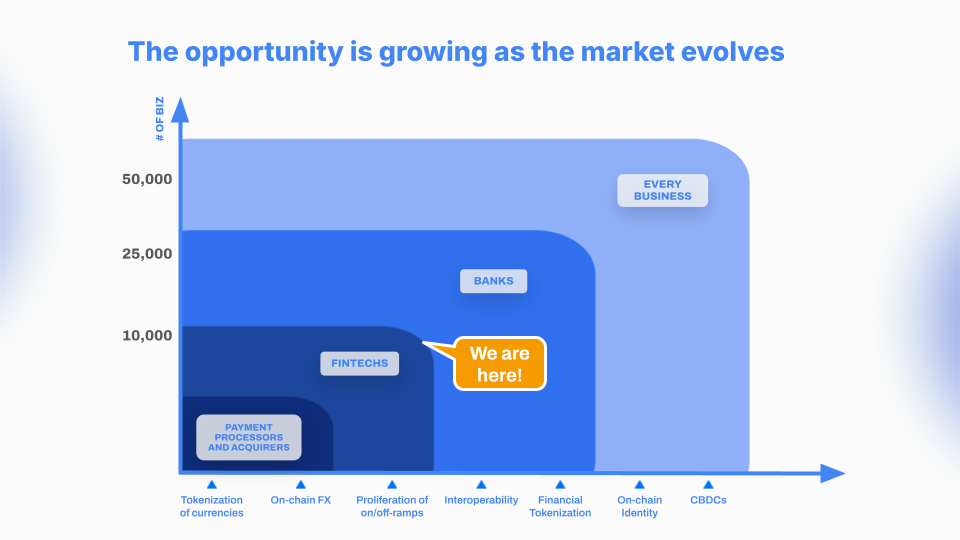Three Years Ago, We Called It
Three years ago, we put together a slide showing how we believed stablecoin payments would evolve within businesses. The premise was simple:
- Blockchain is another payment rail, just like ACH, Wire, SEPA, etc.
- Stablecoins are the best medium to move monetary value on that rail.
- Eventually, all businesses will have to gain access to it, just like they have access to banking or FX.
- There will be driving forces along the way that would contribute to the evolution, but the most critical two are the tokenization of more currencies and the proliferation of legitimate on/off-ramps (the x-axis on Figure 1).
- Regulations underpin all of this. As those become clearer, more encompassing, and more interoperable across key jurisdictions, the other milestones mentioned above will occur faster.

Fast forward to today, and we’re watching this play out in real time. The shift to stablecoins isn’t theoretical anymore—it’s happening. In the last twelve months, we have moved from sporadic exploration to massive experimentation, and now, implementation. Let’s double-click on the journey that PSPs are going through.
Up until now, the default posture for most traditional (and by traditional, I mean fiat only) payment service providers has been Crypto-Remote—keeping a safe distance from digital assets, outsourcing the ‘crypto part’ to third parties, and largely pretending crypto doesn’t exist while still reaping some of the benefits (and obviously being able to market an offering that has digital assets in it).
But that’s changing fast. Regulatory tailwinds, institutional adoption, and competitive pressure are pushing PSPs deeper into digital assets.
PSPs are still going to enter the market as Crypto-Remote businesses, but really, that’s because they want to get to market fast (read: merchants are asking for this, the creator economy is asking for this, and PSPs are starting to worry about getting left behind). Then, once they’ve built up operating experience and internal talent/expertise, they’ll become Crypto-Inside—leveraging their licences to be in the flow of stablecoin payments, owning the customer experience, capturing more of the margin gains, and mitigating risk.
The journey from Crypto-Remote to Crypto-Inside is no longer a multi-year roadmap—it’s happening in as little as 6–12 months.
So, what does this journey look like?
The Crypto Posture Framework
There’s a spectrum of involvement when it comes to PSPs engaging with digital assets (I’m being broad here, but really, it is all about stablecoins), and we define it through three postures: Crypto-Remote, Crypto-Related, and Crypto-Inside.
Each posture requires a different level of control, risk appetite, and licensing needs. And, of course, each has its own implications for revenue, customer experience, and competitive edge.
Crypto-Remote: ‘We’ll Play, But Keep Our Distance’
Definition: a PSP provides access to digital asset payment services but keeps its hands clean—no direct involvement in holding or managing crypto assets. And more important—the assets are not on their balance sheet (while we always say Compliance runs the show, it’s Finance that also has a big say when it comes to holding crypto. Spoiler: they hate it, for now).
How it works: these PSPs rely on licensed third-party providers to handle the digital asset component off their balance sheet. Let’s say a customer wants to send a stablecoin payout – the PSP sends fiat over traditional local or cross-border rails, and the third party handles the on-ramp (from fiat to stablecoin) and distribution.
How this model stacks up:
- Speed to market—no licences, no heavy lifting, just plug-and-play.
- Externalised risk—they don’t have to worry about holding crypto directly.
- Lack of control—customer experience depends on third parties.
- Missed revenue—PSPs don’t get to monetise the full payment flow.
Example: Shift4 is a great example of a PSP that enables stablecoin transactions without directly handling digital assets. They jumped in, using Bridge to power the movement of crypto (and of course, Bridge runs on Fireblocks).
Crypto-Related: ‘One Foot In, One Foot Out’
Definition: a PSP moves closer to the crypto ecosystem but still stops short of holding private keys or managing digital assets in-house.
How it works: instead of staying entirely at arm’s length, these PSPs hold funds at exchanges or custodians. Digital assets are now reflected on their balance sheet, but the PSP itself still doesn’t directly manage wallets. The main concern here is similar to the Crypto-Remote folks—they don’t have the right licences, don’t think there is enough regulatory clarity (yet), etc. The one minor distinction is that they are walking, not crawling.
How this model stacks up:
- Deeper market engagement—they’re building crypto expertise and capabilities.
- Revenue expansion—they can now monetise transactions better.
- Operational complexity—compliance and risk management become bigger concerns.
- Still not fully in control—the PSP still depends on external infrastructure.
Example: Checkout.com operates here, bridging fiat and crypto but relying on partners to manage digital assets.
Crypto-Inside: ‘I Know Kung Fu’
Definition: a PSP fully integrates digital assets within its infrastructure, managing its own wallets, holding private keys, and overseeing stablecoins directly.
How it works: these PSPs are fully embedded in the blockchain ecosystem. They settle transactions on-chain, manage liquidity in-house, and own their customer experience from end to end.
How this model stacks up:
- Full control—they own the transaction flow, customer experience, and settlement process.
- Cost efficiency—eliminates unnecessary intermediaries.
- Competitive edge—as blockchain adoption grows, this will be the gold standard.
- Significant compliance investments—more regulation, more licences, more oversight.
- Higher operational complexity—requires dedicated teams and infrastructure.
Example: Stripe jumped straight from Crypto-Remote to Crypto-Inside by acquiring Bridge, bringing stablecoin settlement fully in-house.
What determines a PSP’s posture perspective?
Every week, the number of conversations I have about stablecoins with PSPs increases. The questions and concerns vary, but the urgency is always the same. As I said, the gold standard is Crypto-Inside. But most PSPs today start with Crypto-Remote.
And here’s why:
- Competitive pressure fuels the need for speed: if your competitors are offering 24/7/365, low-cost stablecoin payments, you don’t want to be the PSP still relying on T+2 settlement. PSPs need to offer a solution, and fast.
- Regulation is moving (slowly) in favour: with SAB-121, the GENIUS act, and regulatory frameworks like MiCA, PSPs are feeling more confident stepping into digital assets. An interim solution gets you going while you work on the right licences.
- Solution pacing: PSPs would like to enter the space but do so gradually (‘crawl, walk, run’) to help acquire the knowledge and operational muscle needed to handle these flows. This also relates to internal expertise in crypto and leadership buy-in, which is there, but cautiously.
How PSPs Move from Remote to Inside
The window for gradually testing the waters is closing fast. So, what does the journey to Crypto-Inside actually look like?
Step 1: Start Crypto-Remote
- Use a third party as an orchestration layer to move funds from a bank account to a liquidity provider.
- The third party handles reconciliation and on/off-ramping.
Step 2: Move to Crypto-Related
- Bring stablecoins onto your balance sheet.
- Work with custodians and exchanges instead of intermediaries.
- Get risk and compliance buy-in—this is often the hardest part.
Step 3: Go fully Crypto-Inside
- Manage your own wallets. Hold private keys.
- Dedicate your security and IT teams—this is now a core business function.
- Set up compliance and travel rule policies.
Final Take: The PSP Crypto Evolution
Stablecoins aren’t a futuristic idea. They’re already transforming global payments, and PSPs that don’t adapt will find themselves playing catch-up.
The question isn’t if PSPs will move toward Crypto-Inside—it’s when and how fast. Some will take the gradual path, moving from Remote ➔ Related ➔ Inside. Others, like Stripe, will skip steps entirely and buy their way in.
The only real mistake? Sitting still.



